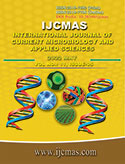


 National Academy of Agricultural Sciences (NAAS)
National Academy of Agricultural Sciences (NAAS)

|
PRINT ISSN : 2319-7692
Online ISSN : 2319-7706 Issues : 12 per year Publisher : Excellent Publishers Email : editorijcmas@gmail.com / submit@ijcmas.com Editor-in-chief: Dr.M.Prakash Index Copernicus ICV 2018: 95.39 NAAS RATING 2020: 5.38 |
The objective of this study was to determine, quantify and disseminate the level of environmental chemical contaminants in the topsoil, water, pasture, milk, blood, feaces, kidney, and adipose tissues from cattle reared in peri-urban slum of Kisumu County. Various samples were collected from Mamboleo, Nyalenda and Otonglo in Kisumu County in the months of April and August 2019 respectively to determine possible seasonal or environmental variability of contaminants. Inductively Coupled Plasma Mass Spectrometry (ICP-MS) was used to identify and quantify the level of toxic heavy metals and the results were compared to WHO food safety limits.Flotation method was used to determine Helminth’s infections. Viable bacterial cell counts were determined using the Spread-Plate method. The heavy metals analyzed were: Lead (Pb), Mercury (Hg), Cadmium (Cd), Arsenic (As) and Copper (Cu). One-way ANOVA (Analysis of Variance) test was used to determine significant difference in the mean level of heavy metals. There were variations in mean heavy concentration levels between the two visits (p<0.05). Helminthosis was prevalent (59.5%) and total Fecal Egg Count (FEC) varied across samples. Study findings show varying heavy metal concentration levels which exceed WHO/FAO food safety limits implying livestock kept in peri-urban setting of Kisumu town are at a risk of ingest contaminated pasture, threatening food safety among consumers. This study recommends policies aimed at mitigating pollution from chemical contaminants and other anthropogenic activities and farmer sensitization on better farming system with limited risks on food safety and animal-human food chain.
 |
 |
 |
 |
 |